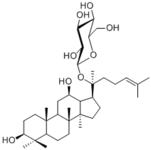
|
| Compound | Compound K |
| Animal species | human intestinal microflora |
| Metabolism parameters |
Oral administration |
| Metabolites |
Compound K
|
| Crude drug | Ginseng |
| References | 1) Jayeul Lee, Euiju Leea, Donghyun Kim, Junhee Lee, Junghee Yoo, Byunghee Koh, Studies on absorption, distribution and metabolism of ginseng in humans after oral administration. Journal of Ethnopharmacology, 122: 143–148 (2009). 2) Zhou Wei, Zhou Pei, Advances in the study of ginsenoside compound K. Acta Pharmaceutica Sinica(薬学学報), 42, 917-923 (2007). |
| Remarks | The study was aimed to characterize the absorption, distribution and metabolism of ginseng in human subjects using pharmacokinetic experiments based on the metabolism by microflora from feces. Fecal microflora from humans transformed ginsenoside-Rb1 (G-Rb1) and ginseng extracts into compound K (C-K). Subsequently, Cmax, Tmax and AUC for C-K in plasma were estimated by quantitative analysis using LC–MS/MS. C-K was absorbed into the blood 24 h after oral administration of ginseng, with average values for Tmax, Cmax, and AUC as follows: 10.76±2.07 h, 27.89±24.46 (ng/ml), and 221.98±221.42 (μg h/ml), respectively. There was a correlation between the C-K transforming activity of G-Rb1 and the C-K transforming activity of ginseng extract by intestinal microflora (Spearman's correlation coefficient = 0.402, p < 0.05). [Lee et al., Journal of Ethnopharmacology, 122: 143–148 (2009)] Distribution of compound K in the plasma as Cmax, Tmax and AUC. Cmax: maximum plasma concentration; Tmax: maximum drug concentration time; AUC: area under the blood concentration curve. Cmax and Tmax were estimated directly fromthe plasma concentration–time data. AUC was calculated by using the log-linear trapezoidal rule for the total period and extrapolated to infinity. [Lee et al., Journal of Ethnopharmacology, 122: 143–148 (2009)] |

